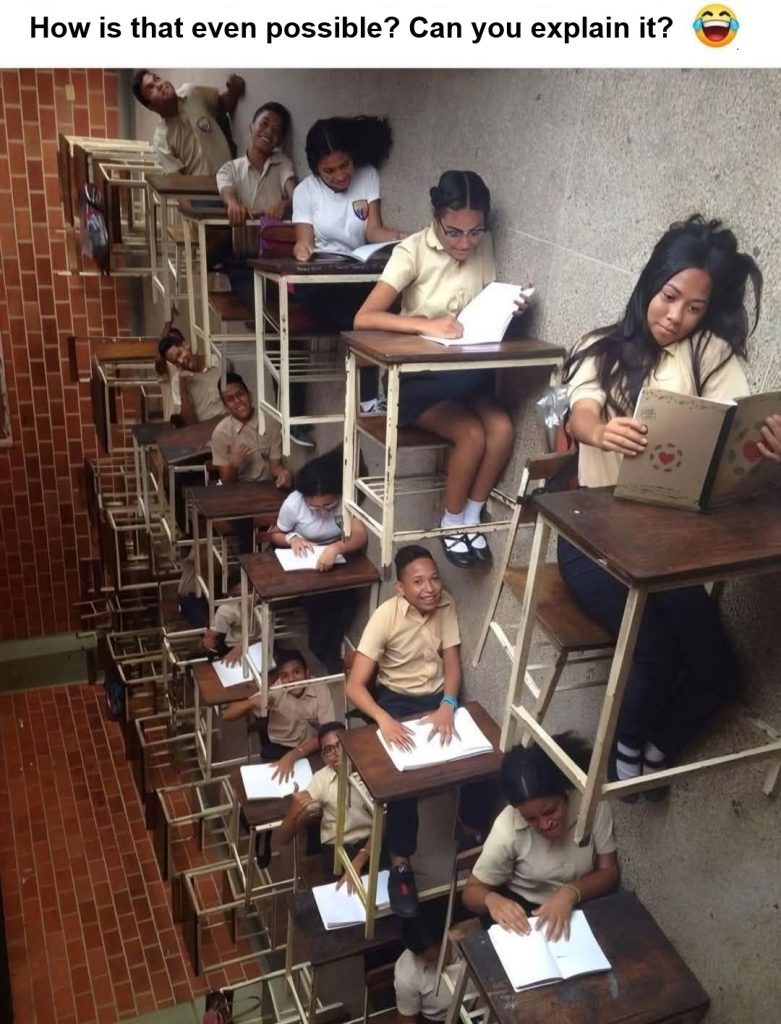We live in a world filled with visual challenges that often trick our minds. One fascinating aspect of modern life is how images can manipulate our perception, leaving us questioning reality. One such mind-bending visual puzzle that has captured the internet’s attention is the image that makes us wonder: “How is this even possible?”
At first glance, the image appears to showcase a classroom where students are sitting at desks stacked vertically on a wall. It’s bizarre, surreal, and downright confusing. But is it really what it seems? Let’s break down the illusion and uncover the truth behind this seemingly impossible scene.

Why Are Optical Illusions So Compelling?
Optical illusions capture our attention because they challenge our brains to make sense of conflicting visual information. Our minds are wired to process the world based on experience and pattern recognition. When an image defies those patterns, it sparks curiosity and a desire to understand the mystery.
The “How Is This Even Possible?” puzzle is a perfect example. At first, our brain interprets the scene as a gravity-defying classroom. Yet, deep down, we know something doesn’t add up. This contradiction between what we see and what we know is what makes optical illusions so captivating.
Decoding the Puzzle: Why It’s So Confusing
When you first look at the image, your brain instinctively interprets the scene as a row of students sitting at desks attached to a vertical wall. It feels strange and unnatural because, obviously, humans can’t sit upright on a wall. Yet the photo looks convincing, and that’s where the illusion takes hold.
The challenge lies in how our brains interpret spatial relationships. The image creates an illusion by manipulating angles and perspectives. The biggest clue is the red brick surface on the left side of the image. At first, it appears to be a vertical wall, but this is actually the floor. The concrete surface behind the students, which seems to be a vertical backdrop, is actually the ground.
Video: Dhimaag hilane wala illusion opticle 🧐 #viral #shorts funny videos like and subscribe
Changing Your Perspective: Seeing Through the Illusion
To truly understand the trick, you need to shift your perspective. Sometimes, seeing the truth requires letting go of our first impression and looking at the image from a different angle.
Here’s how to spot the trick:
- Focus on the Bricks: Notice that the bricks on the left resemble the texture of a floor rather than a wall.
- Pay Attention to Gravity: Think about how gravity would affect the students if they were really sitting on a wall. It doesn’t match up, does it?
- Consider the Ground: The concrete area behind the students looks like a vertical wall, but it’s actually the ground they are lying on.
- Rotate the Image in Your Mind: Imagine rotating the image 90 degrees to the right. Suddenly, it all makes sense – the students are lying down with desks placed horizontally, but the photo is rotated to trick your perception.

Why Does Our Brain Fall for This Trick?
Our brains process images based on context and prior knowledge. In this case, seeing desks naturally leads us to assume they are upright, as they would be in a typical classroom. The mind quickly fills in the gaps, convincing us that the students are sitting upright rather than lying down.
This phenomenon is rooted in cognitive bias – our brains try to make sense of visual input based on what we’ve learned and experienced. The creators of this puzzle cleverly exploited this bias, leading most people to the wrong conclusion at first glance.
The Revelation: How the Illusion Works
After reevaluating the image and adjusting our mental perspective, we understand that the photo was intentionally rotated 90 degrees to the right. The students are not defying gravity but are simply lying on the ground. The desks are arranged horizontally, giving the illusion of a vertical stack when the image is viewed from a different angle.
It’s an ingenious way to manipulate our perception by using simple elements like angles and context. Once you realize the trick, the illusion loses its power, but it leaves you with a sense of awe at how easily our minds can be deceived.
Video:
What Can We Learn from This Puzzle?
This visual puzzle teaches us a valuable lesson about perception: things are not always as they seem. In life, much like in this puzzle, we sometimes jump to conclusions based on limited information. By shifting our perspective and being open to new interpretations, we can uncover the truth.
The ability to question what we see and think critically is essential, especially in a world where illusions aren’t just visual but can also be metaphorical. Whether it’s interpreting a puzzling image or understanding a complex situation, being willing to rethink our first impression can lead to surprising insights.
Conclusion: Why This Puzzle Captivates Us
The “How Is This Even Possible?” puzzle is more than just a visual trick; it’s a reminder of how easily our minds can be fooled. It challenges us to slow down, reconsider, and approach problems from new angles. The sense of accomplishment that follows the realization is deeply satisfying – a small victory against our own cognitive biases.
Next time you come across a puzzling image or an unusual situation, remember to pause and rethink. Often, the answer lies not in what you see but in how you choose to see it.
If you enjoyed unraveling this visual puzzle, stay curious and keep challenging your perception – because sometimes, reality is just a matter of perspective!